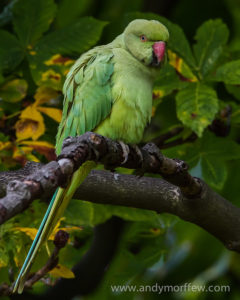Parakeets were once a rare site in Europe but new research co-led by the University of Brighton shows there are now as many as 85,000 across the continent – and the numbers are increasing all the time.

In fact, the non-native Ring-necked Parakeet (Psittacula krameri) is now a common sight in many parts of the continent – and they could be posing a major threat.
Researchers are now asking members of the public to help keep tabs on numbers by reporting sightings.
The new study, conducted by Dr Rachel White, Senior Lecturer in ecology and conservation from the University of Brighton’s College of Life, Health and Physical Sciences, and European colleagues as part of the ParrotNet research network, has shown that parakeets are on the march across European cities.
The research provides an overview of the state of the Ring-necked Parakeet populations across Europe, along with the most detailed estimate of the total number of European populations so far. In East and Northern Europe, Ring-necked Parakeets remain scarce, but across other parts of the continent, numerous growing populations can be found. The European total has been estimated in this study to be no less than 85,000 birds.
Dr White said: “Invasions by non-native species are considered a major threat to biodiversity, agriculture and sometimes human health. Ring-necked Parakeets in Europe originate predominantly from India and Pakistan. They are clearly very successful invaders and although serious impacts are currently unknown, the enduring, strong growth of their populations raises concerns.
“In Israel, Ring-necked Parakeets are culled because of alleged damage to sunflower crops, date palm and almond trees while in Spain, it is no longer legal to breed these parakeets as pets, to reduce the risk of escapees.
“Since the early 1970s, at least 90 Ring-necked Parakeet populations have established in 10 European countries and most of these populations are growing exponentially. It is, therefore, important to keep track of this avian invader.
“Ring-necked Parakeets gather at communal roost sites to spend the night, and thousands of parakeets can gather at such sites. Roost counts consequently are an excellent place to conduct population counts. Yet, because of ongoing range expansion, it becomes harder and harder to locate all roost sites and to find sufficient volunteers to conduct such roost counts.”
The team is asking members of the public to help by reporting Parakeet sightings through mobile apps or websites such as BirdTrack http://app.bto.org/birdtrack/main/data-home.jsp or iNaturalist http://www.inaturalist.org/projects/alien-parrots-observatory
For facts about parakeets, go to: https://drive.google.com/file/d/0B0NkgeeqvGodbUV6REdSODJSaFE/view?usp=sharing
The research is published in the Open Access journal ‘The Open Ornithology Journal” (http://benthamopen.com/ABSTRACT/TOOENIJ-9-1), and more information on invasive parakeets in Europe can be found via the ParrotNet website (http://www.kent.ac.uk/parrotnet). ParrotNet is an EU COST Action (ES1304).
For more information on the university’s research, go to:
https://www.brighton.ac.uk/research/our-research/life-health-and-physical-sciences/research-groups/ecosystems-and-environmental-mngmt/european-network-on-invasive-parakeets.aspx







